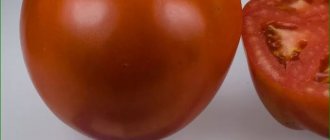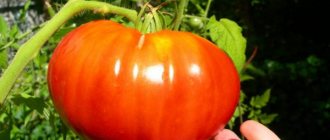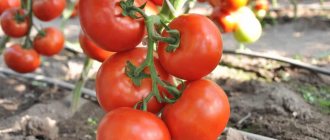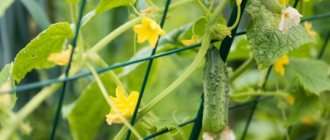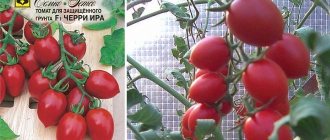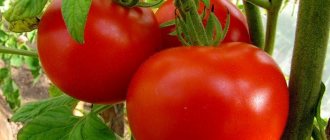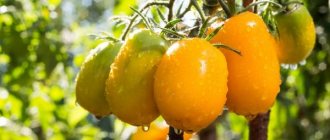Characteristics and description of the variety
The f1 hybrid was developed by Alexey Alekseevich Mashtakov. It was added to the Russian State Register for the North Caucasus (6) region more than 10 years ago, in 2015. Recommended for growing in open ground.
Distinctive features
The type is determinate, plant height is 60-80 cm. The bushes are spreading, the foliage is dense, the leaves are medium-sized, dark green. The first inflorescence is laid above 5-6 leaves, subsequent ones - every 2-3 leaves.
An early ripening species, 80-90 days pass from the moment of germination to full ripening.
Productivity is high, from 1 sq. m, up to 11 kg of fruits are collected, provided that 5-6 seedlings are planted per 1 sq. m. m.
It is characterized by increased resistance to diseases such as tobacco mosaic virus and macrosporiosis, but is susceptible to late blight, so systematic prevention is recommended.
The tomato adapts well to heat and drought, but excess moisture and low temperatures have a detrimental effect.
The crop does not need pinching despite the large number of side shoots, but it cannot do without gartering low-growing bushes. When vegetables ripen, the branches cannot support their weight and break.
Fruit characteristics
The average weight of one fruit is 80-100 g, round shape, rich red color. The taste is excellent, sweet with obvious sourness, the pulp is juicy. There are 4-6 seed chambers. The peel is dense and not prone to cracking. Ripe vegetables are rich in vitamin C.
Universal purpose: excellent for fresh consumption in various dishes and for winter preparations. Tomatoes are also processed into tomato products for the production of juices, ketchups, adjika, and pastes.
Ripe vegetables can be stored for a long time without losing their presentation and can withstand transportation over any distance. For these reasons, entrepreneurs breed the hybrid for sale.
The photo shows Irishka tomatoes.
Diseases and pests
Hybrid Irishka is highly resistant to the following tomato diseases:
- powdery mildew;
- tobacco mosaic;
- microsporiosis.
Photo of a tomato affected by late blight
This tomato has low resistance to late blight.
But due to the fact that the bushes are harvested around mid-July, the bushes do not have time to be affected by this disease, the activity of which appears only by August.
How to grow seedlings
Sowing seeds for seedlings begins 2 months before planting in the ground. Before sowing, seeds undergo mandatory preparation.
Seed preparation
The seed material is laid out on the table and carefully inspected for visible damage. Then place it in a saline solution for 10 minutes to determine if the seeds inside are empty or not.
Those that float to the surface are not suitable for sowing. Then the grains are disinfected in a pink solution of potassium permanganate for 20 minutes. After disinfection, they are washed with running water and dried.
Reference . After disinfection, up to 30% of seeds lose their viability.
To improve germination, grains are germinated on damp gauze for 2-3 days. To do this, they are laid out on gauze, slightly moistened with warm, settled water and left in a dark place at a temperature of at least 27°C. As the gauze dries, moisten it. After the sprouts appear, the seeds can be sown in the ground.
Container and soil
The soil is prepared from garden soil, humus and peat in equal quantities. All components are thoroughly mixed and the resulting mixture is disinfected with a hot solution of dark potassium permanganate or steamed in an oven at a temperature of 50-60°C for at least 10 minutes.
Plant in a common wooden box or individual plastic cups and peat pots. Planting containers are filled two-thirds with the prepared soil mixture; small drainage holes are first made at the bottom so that excess moisture does not stagnate in the containers.
Sowing
The grains are sown in furrows to a depth of 2 cm. The distance between the seeds is left 2.5-3.5 cm. Sprinkle peat on top, level it, slightly moisten it with warm, settled water and cover the containers with film to create a greenhouse effect. Containers are left in a bright and warm room at a temperature of 23-25°C. At lower temperatures, seedlings appear much later.
The film is periodically removed for ventilation and the soil is slightly moistened as it dries.
Seedling care
When seedlings appear, the containers are moved to a more illuminated place, on the windowsill. As the top layer of soil dries out, water the seedlings with warm, moderate water using a shallow watering can or tablespoon. Water lightly without flooding the sprouts. Excess moisture has a detrimental effect on young roots.
After watering, carefully loosen the soil with a wooden stick or a regular fork. Loosening helps saturate the soil with oxygen.
When 2-3 true leaves appear, the seedlings dive, planting them in separate containers. During picking, weak bushes are disposed of, leaving only strong and healthy ones for further growth.
Reference . When sowing seeds in peat pots, picking seedlings is not required. In addition, the walls of peat containers contain many useful substances that additionally nourish young roots.
During the picking period, the seedlings are fed with liquid fertilizer for tomatoes. This first feeding is most important for weakened bushes.
2-3 weeks before transplanting, the seedlings are hardened off by taking the containers outside for 1 hour during the daytime. Gradually, the interval of time spent outdoors is increased to 12-13 hours. At the same time, the night temperature in the room is reduced to 14°C. The hardening procedure helps to quickly adapt to outdoor conditions after transplantation and strengthens the immunity of young plants.
How to grow tomatoes
After 2 months, the seedlings are transplanted into the ground. They are planted in a greenhouse 2 weeks earlier than in open beds. But do not forget that by the time of replanting the soil should warm up to +15...+17°C.
Landing
The soil for tomatoes is prepared 2 weeks before transplanting. Too dense soil is loosened with lowland peat or river sand. Then the ground is dug up with the addition of mineral fertilizers or wood ash.
Reference . Lowland peat contains a large amount of nutrients, due to which it improves the structure of the soil, saturating it with organic matter.
Planting pattern: 40 cm – distance between seedlings, 60-65 cm – row spacing. For 1 sq. m place no more than 6 plants. Wide row spacing is left for regular ventilation of the bushes and sufficient sunlight.
Transplant the seedlings into holes 20 cm deep . After planting, the holes are watered generously with warm, settled water, compacted and the bushes are left for 1 week to get used to the new place. The most suitable time for transplantation is early morning or evening after sunset.
Further care
Regular watering is established as adaptation progresses, but not more than 2 times a week. On dry and hot days, the amount of watering is increased to 3 times a week. Water with warm water, strictly at the root, without touching the leaves, in the evening or early in the morning.
Attention ! When watering during the day, plant leaves can get burned.
After watering, the soil is loosened, hilled up and weeds with roots are removed. To retain moisture in the soil, the beds are mulched with straw. Weeds are also used as mulch, which, when rotting, provide additional nutrients to the root system.
Over the entire season, the crop is fed three times. The first fertilizing is applied 2 weeks after transplantation. Feed with organic matter or nitrogen complexes. As organic matter, mullein infusion or bird droppings are used in a ratio of 1:15.
The second time is fed during flowering with mineral fertilizers containing mainly potassium and phosphorus.
The third fertilizing is applied during the fruiting period. The fertilizer is the same fertilizer that was used to fertilize it during the flowering period: a full complex of minerals with an emphasis on potassium and phosphorus.
Features of care and possible difficulties
Plants do not require obligatory pinching, although many gardeners prefer to remove all excess shoots up to the first cluster. This technique reduces yields, but protects against the spread of pathogenic fungi. In addition, removing unnecessary shoots ensures better ventilation of the bushes.
As for the garter, opinions are divided: some consider the procedure mandatory, others ignore it. The fact is that in different regions the bushes reach different heights, and with a growth no higher than 50 cm, the plant really does not need fixation.
However, it is necessary to have additional supports on hand in case the fruit-bearing branches cannot support the weight of ripe fruit and begin to break. For gartering, a wooden or metal support is installed next to each bush, to which the fruitful branches are fixed as they grow.
Diseases and pests
The culture is resistant to powdery mildew, tobacco mosaic virus and macrosporiosis, but it does not have immunity to late blight. Late blight is a dangerous fungal disease that often affects the nightshade family and can destroy up to 75% of plantings. Therefore, for those crops that are not endowed with persistent resistance to late blight, it is most important and necessary to carry out appropriate preventive measures.
Prevention measures include loosening the soil, mulching the beds, moderate watering with control of humidity and regular ventilation of closed structures. Also, plants are treated with fungicides several times a season, as these drugs reduce the risk of disease development. The most common drugs used to prevent late blight are Fitosporin and copper sulfate.
If the hybrid is planted in a greenhouse, first replace the top layer of soil, disinfecting the new soil without fail. It is in the upper layer that pathogenic microorganisms and many pest larvae overwinter, which begin to reproduce successfully in the spring. A dark potassium permanganate solution is used as a disinfectant.
If, after all, the fungus has infected the plants, the drug “Hom” is used to combat it. The solution is prepared from 40 g of product and 10 liters of water.
Important ! Potatoes are also processed together with tomatoes, since they are the ones that cause disease in tomato bushes, especially when planted nearby.
The most dangerous pests for tomatoes are aphids, Colorado potato beetles and whiteflies. A soap solution used to treat the stems of affected plants will help get rid of aphids. If there is a large accumulation of it, they are treated with insecticides “Decis” and “Karate”.
The drug “Prestige” is effective against the Colorado potato beetle, and pheromone traps are installed against the whitefly butterfly.
Planting and care
The Irishka variety is grown by seedlings. Seeds are sown on March 1-15. They are transplanted to the site after 55-65 days from the moment of germination. They ripen on average 3 weeks from the moment the ovaries appear. In general, this variety is unpretentious, but it is necessary to observe the correct watering regime and tie up the trunks. During the growing season, 3 or 4 feedings are carried out, for which complex organic and mineral fertilizers are used.
Before flowering begins, spraying with various mixtures of nutrients can be carried out. Thanks to foliar feeding, the growth of green mass and the formation of ovaries are improved. During summer drought and heat, treating bushes with a solution of boric acid in water is useful (for this, take 1 teaspoon of acid per 1 bucket of water).
This avoids color fading. In order to prevent diseases, primarily late blight, the bushes are sprayed with antifungal drugs. At the same time, the greenhouse is constantly ventilated. Occasionally, this variety is attacked by aphids. In this case, modern drugs such as Pirimor, Intavir and Decis can be effectively used against the pest.
Irina tomato seeds are sown in the first half of March. Hybrid material does not require treatment with activators and disinfection from fungi.
For sowing, use purchased or self-prepared soil mixture. Main components for looseness and fertility:
- leaf turf;
- compost;
- silt;
- peat;
- sand;
- wood ash.
For 10 kg of substrate add 30 g of superphosphate and 10 g of potassium salt.
The soil is treated with 1% potassium permanganate or boiling water, or alternatively, it is calcined in the oven.
How to grow:
- moderate watering 2-3 times a week, the water norm for 1 bush is 5-6 liters;
- leading into 2-3 stems;
- garter to support;
- mulching with a layer of green manure or straw.
For fertilizing, use a 1:10 diluted solution of mullein or manure. A phosphorus-potassium composition is added to it. Be sure to fertilize during flowering, setting, and ripening.
Tomatoes are planted in the greenhouse from the end of April, the optimal air temperature is not lower than 18 degrees, the soil temperature is not lower than 12 degrees.
Early maturing / Medium growing
User rating: 5/5
Mid-season / Mid-season
User rating: 5/5
Early maturing / Medium growing
Plant care is pretty standard. They care for the variety like other tomatoes:
- Abundant, timely watering, which is best done in the morning with warm water, being careful not to get liquid on the leaves.
- Loosening will help the plant “breathe” its roots. The procedure is carried out after watering.
- Removing weeds.
- Formation of bushes.
- Apply mineral or organic fertilizers every two weeks.
- Tying up branches.
Nuances for open ground and greenhouses
Hybrid Irishka f1 is recommended for breeding in the North Caucasus District and Central Regions. As a rule, in open ground the taste characteristics are preserved exactly as stated by the manufacturer. However, tomatoes are also grown in cold regions under greenhouse conditions. According to the characteristics and reviews of gardeners, the taste of ripe tomatoes is noticeably different from those from the south.
It is best to prepare the soil in the fall, fertilizing it with organic matter and superphosphate. This way it is better saturated with useful substances, which affects its fertility. Places for planting are chosen to be sunny, protected from drafts and, if possible, elevated.
It is not necessary to form a hybrid. Many gardeners cut off all the stepsons, thereby accelerating the ripening of the fruit. But at the same time, this method leads to a decrease in yield. This is usually done when there is a real threat of late blight.
Planting conditions depend on the region where the crop grows. In the southern area, per 1 sq. m place 6 seedlings, in the middle zone - no more than 5.
Early hybrid of tomatoes Irina: for salads and canning
Early hybrids offered by domestic breeders make it possible to significantly shift the timing of tomato harvesting
For gardeners in Siberia, the Urals, and the middle zone, this is very important, since with a short summer season it is necessary to beat the weather every day. Hybrid Irina F1 - will not only delight you with early ripening, but will also surprise you with the excellent taste of the fruits
Young lady in a greenhouse and in a garden bed
There are many varieties and hybrid forms of tomatoes with beautiful sonorous female names. We present another one - a very productive tomato Irina, a first-generation hybrid produced by Agro. However, hybrid seeds are also offered by Plasma Seeds and Siberian Garden.
Ask and receive useful advice from professional gardeners and experienced summer residents.>>
Irina was included in the State Register in 2001; cultivation in open ground, under film covers, is recommended.
Bush up to 1 meter high, stocky, strong. On ridges, plants may be slightly lower, but according to reviews from summer residents, the taste of fruits grown in open ground is an order of magnitude higher than those grown in greenhouses.
There are many leaves, they are medium in size, without pubescence, and rich green in color. The first raceme is formed already above the 6-7th leaf, the next inflorescences occur at intervals of 1-2 leaves. There are 6-7 fruits in a brush.
The tomatoes are round, weighing 100-120 grams. The skin is dense, but not hard, but thin, dark red in color. Typically, such hybrids have a green spot near the stalk, which not everyone likes.
Irina’s fruits do not have it, and there is also no ribbing. The flesh is fleshy and tender. The taste is excellent, and as summer residents note, the tomato is truly sweet. From 4 to 6 chambers are formed inside, there are few seeds.
Where to use the fruits of the Irina variety? They are suitable for salads, slices, and sandwiches. Tomatoes are delicious canned, in marinades, and also as a variety of stews.
Delicious juice, thick sauce, puree, and tomato paste are obtained from the pulp. In a dark place at the appropriate temperature, this tomato hybrid can be stored for up to 1.5 months; it is suitable for transportation.
Advantages and disadvantages
One of the main “advantages” of the Irina tomato is the high taste of the fruit, which is noted by everyone. For hybrids this is a very important, but not the only characteristic.
We list in the description the advantages and disadvantages of the variety.
- Tomato has an early ripening period - 80-95 days.
- Differs in compact sizes.
- Unpretentious.
- Simple care for tomatoes is enough, although you should not forget about removing stepsons and forming a bush.
- Forms large fruits.
- The tomatoes are even in bunches and have an excellent presentation.
- The variety is resistant to diseases, including TMV and fusarium.
- Weakly affected by pests.
- Fruits of universal purpose.
For farmers and hobbyists, the hybrid tomato Irina F1 is an excellent choice, especially since it can be grown in any region. From one bush you can harvest 9-10 kg of tomatoes.
The plant is not afraid of temperature changes, although the yield will be higher under favorable conditions. In shelters and polycarbonate greenhouses, the variety produces larger fruits; in beds the weight will be less.
Harvesting and application
Vegetables ripen at the same time, so you should prepare containers intended for collecting fruits in advance. Tomatoes should not be allowed to overripe; it is better to pick them unripe. The tomatoes will take on color on their own at room temperature.
The purpose of ripe vegetables is universal. They are consumed fresh, making a variety of salads, first and second courses. They are baked with meat and fried with eggs, and used to make pizza.
Small tomatoes are great for whole-fruit canning, marinades and pickles. Tomato products do not lose their taste: they make excellent juices, pastes, adjika and ketchups.
Ripe vegetables are stored for a long time and can withstand long-term transportation without losing their presentation. Due to this, the hybrid is grown commercially in many regions.
Description of tomato Irishka
Hybrid Irishka F1 is early ripening, the fruits ripen on the 87-92nd day of tomato development after germination. The bush of a productive tomato variety of determinate type is low, rising to 55-60 cm. The plant is spreading due to stepsons. On fertile soil it reaches 80-85 cm without compromising productivity. The stems are sparsely leafy, which reduces labor costs for caring for tomatoes. This is especially important in a greenhouse, where for a successful harvest, they must first tear off some of the leaves from the bottom, and then from the top of the stem. The Irishka F1 tomato leaf is medium in size, characteristic of the species in color and shape.
The first clusters with flowers are created in the axils of leaves 5-6. The inflorescences of the variety branch 1 or 2 times and belong to the intermediate type. The next fruit branches are laid after 1-3 leaves. One plant of a productive variety produces up to 7 fruiting clusters. 5-7 tomatoes ripen on the branches.
Hybrid Irishka is recommended to be grown with stepsons to increase yield. Other gardeners prefer to get an earlier harvest from the variety, which can be achieved by removing all the stepsons. In this case, the plant directs forces to form fruits on existing clusters.
Description of fruits
The fruits of the Irishka f1 tomato are round, there is no ribbing. Almost all varieties of tomatoes are uniform in size, average weight - from 45-80 g to 130 g, with good care there is also a large mass. Glossy thin skin of bright scarlet color, evenly colors the entire surface of the tomato, without green spots around the stalk. The density of the skin of the Irishka variety contributes to the good preservation of fresh fruits, which can be stored in the refrigerator for up to 2 weeks. Ripe, red tomatoes can also hang on the bush for several days without cracking. The variety is attractive for growing in personal plots and for summer residents, since it does not require close care.
The pulp of the tomato Irishka f1 for salad direction is dense and meaty. The fruit is divided into 4-8 chambers with seeds that cannot be collected for propagation. Hybrid plants do not repeat the qualities of conventional cultivation by collecting seeds from the tomato you like. The fruits of the Irishka variety contain from 3.6 to 5-6% dry matter. Thanks to this concentration, tomatoes are well stored and can withstand transportation. The taste of the tomato is pleasant, with a slight sourness and noticeable sweetness, since they contain up to 4% sugars. 100 g of fruit contains up to 30 mg of vitamin C.
Tomato variety for universal use. They are used fresh for salads. Dense slices look appetizing in winter assorted preparations. Small, uniform tomatoes are ideal for pickling. Overripe products are processed for tomato pastes and purees.
Advantages and disadvantages of the variety
Positive aspects of the hybrid:
- ability to take root in all regions;
- adaptation to drought and high temperatures;
- ease of care;
- early ripening;
- does not require pinching;
- high fruiting rate;
- excellent taste of fruits;
- amicable maturation;
- high commercial quality;
- long-term storage;
- long transportation;
- versatility in cooking.
The disadvantages include:
- susceptibility to late blight;
- fear of low temperatures;
- impossibility of independently preparing seeds for planting.
Bush care
Further care for tomato crops is standard. It consists of:
- Polivov. The interval between them is 5-6 days;
- Applying fertilizers at the roots (three times per season);
- Two or three foliar feedings. They will improve the formation of tomatoes in the heat, and also support immunity during the seasonal rains;
- Loosening between rows;
- Mulching the soil;
- Tying branches to a support.
No pinching or bush formation is required. A timely harvest during the period of mass ripening of tomatoes will prolong fruiting and increase the size of the fruit.
Farmer reviews
Many gardeners admit that they decided to plant a hybrid after seeing photographs that in no way exaggerate the colorfulness of ripe fruits. In most cases, gardeners opt for the Irishka hybrid, refusing to experiment with other species.
Victoria, Irkutsk: “I planted seedlings in the ground at the end of May, they took root well. There were a lot of tomatoes, so the bushes had to be strengthened with supports. We collected the harvest until mid-September - all the fruits are round, even, approximately the same size. I really liked the taste of the tomatoes, especially in the rolls. I’ll definitely plant more!”
Ivan, Vladimir region: “I planted a hybrid in a greenhouse. The bushes grew up to 50 cm, I didn’t tie them up or take stepson. Very friendly good harvest. The vegetables are sweet and sour, ideal for pickling. The dimensions are just right for the jar.”
Features of agricultural technology
The hybrid is grown by seedlings. The seedlings are growing intensively. 45-50 days after germination they are ready to be transplanted into the ground. Recommended scheme for planting tomatoes in the garden:
- 30-40 cm - distance between plants in a row;
- 70 cm - distance between rows.
Features of cultivation:
- Some gardeners do not plant tomatoes at all. Others completely remove all stepchildren. In the second case, the harvest will be earlier, but in general the plant will produce less fruit during the season.
- Immediately build the supports and think about how to attach them to them. A low-growing bush will not support the weight of ripening tomatoes.
- Pick tomatoes in a timely manner to redirect the plant's energy to form new fruits.
